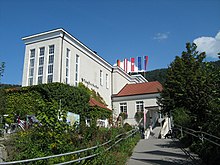Pfänderbahn
The Pfänderbahn is a cable car in Bregenz in the Austrian state of Vorarlberg . It connects the valley station at 419 m above sea level. A. with the mountain station 1022 meters above sea level near the Pfänderspitze .
history
planning
Initially, the construction of a cog railway was considered, and finally a suspension cable car was chosen, as this was cheaper and there would be no need to clear snow. The terrain consists of gravel and sandstone, not rock. The cable car originally only needed four supports on this difficult ground. The construction was based on experience in supplying positions in the First World War in the Dolomites.
Construction and opening
The Pfänderbahn was built from July 1926 to February 1927 and was opened by Federal President Michael Hainisch on March 20, 1927 as Austria's third cable car . The construction work was carried out by the company Adolf Bleichert & Co. from Leipzig - Gohlis . The plans for the station buildings came from the Bregenz architect Willibald Braun .
"Pfänderbahn new"
In October 1994 the cable car system was comprehensively renewed:
- Replacement of the gondolas; they are now fully glazed and offer space for up to 80 people.
- Reduction of the supports from four to two; thus a higher rope guidance is offered.
- Installation of a hydraulic device for rope tensioning: the shaft weight of 120 tons is passed on to the ropes by means of this hydraulic system. The advantage of this construction is that the shaft weight geometry could be separated from the rope geometry.
- The rope safety brakes have been omitted, the pull rope has been dimensioned correspondingly larger.
- In the stations, sliding pavilions (“sliding platforms”) are used to make optimal use of the available space.
- A hydraulic leveling device stabilizes the gondola in the parking position, so that getting in and out is particularly easy and also easy for wheelchair users.
The renovation work was carried out under the direction of Doppelmayr . In 1998 the Pfänderbahn Museum was opened in the valley station of the railway.
Technical specifications
The difference in altitude of 603 meters is overcome over a distance of 2063 meters using a two-lane aerial tramway. The inclined section is around 1980 meters, the horizontal length around 80 meters. The track width in the stations is reduced to 2.5 meters, but on pillar 1 it is ten meters. With an average incline of 31%, the cabins move at a speed of up to twelve meters per second . The journey time is around six minutes, and 80 people can be transported every ten minutes if necessary.
The gondolas are driven from the mountain station by means of two 500 kW direct current electric motors. The cable car is supplied with power via two separate power supplies. There is also an emergency power generator and batteries. Communication between the valley and mountain stations as well as cars 1 and 2 takes place through inductive transmission via the pull rope.
The valley station of the cable car is in the municipal area of Bregenz, the majority of the route and the mountain station in the municipality of Lochau .
Web links
- Official website of the Pfänderbahn.
Individual evidence
- ^ Corinna Raupach: Like the country, like the railway. In: Südkurier from June 19, 2017.
- ↑ a b Entry at Seilbahngeschichte.at ( memento from August 29, 2010 in the Internet Archive ) accessed on May 22, 2011
Coordinates: 47 ° 30 '17.4 " N , 9 ° 45' 10.5" E












